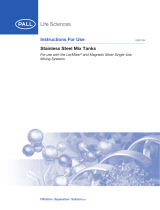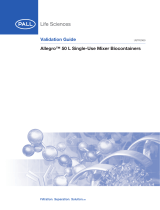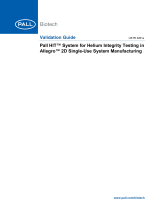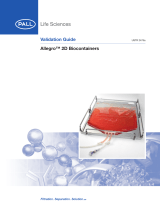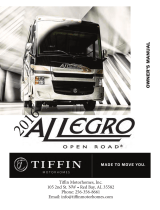Page is loading ...

Restricted - Company Proprietary
BIOTECH
Instructional Documentation
USD3709
Pall Pneumatic Box Standard
Instructions For Use

2
Restricted - Company Proprietary
Contents
1. Introduction .............................................................................................................................................................................. 4
1.1 Target groups of this document ...............................................................................................................................................................................................4
1.2 Signs and symbols in this document .................................................................................................................................................................................. 5
1.3 Support contact address ................................................................................................................................................................................................................... 5
2. Safety .......................................................................................................................................................................................... 6
2.1 Legal regulations .......................................................................................................................................................................................................................................6
2.2 Intende d use ...................................................................................................................................................................................................................................................6
2.3 Unauthorized modifications, m aintenance, and re pair .................................................................................................................................. 7
2.4 Safety Equipment .....................................................................................................................................................................................................................................8
2.4.1 Control and safety valves.................................................................................................................................................................................................................. 8
2.4.2 Compressed air maintenance unit ....................................................................................................................................................................................... 8
2.4.3 Emergency Button ................................................................................................................................................................................................................................. 8
2.4.4 Main Switch..................................................................................................................................................................................................................................................... 9
2.5 Safety Check..................................................................................................................................................................................................................................................10
2.6 Damage to property.............................................................................................................................................................................................................................10
3 Function and design..............................................................................................................................................................10
2.7 System overview........................................................................................................................................................................................................................................ 11
2.8 Overview Processing Hardware ............................................................................................................................................................................................... 12
2.9 Measuring and control units ....................................................................................................................................................................................................... 13
2.10 Compresse d air maintenance unit ...................................................................................................................................................................................... 13
3. Transport ..................................................................................................................................................................................14
4. Installation................................................................................................................................................................................ 15
4.1 Preparing installation.......................................................................................................................................................................................................................... 15
4.2 Connecting supply ................................................................................................................................................................................................................................. 15
4.3 Connecting power supply ..............................................................................................................................................................................................................16
4.4 Connecting air supply to the maintenance unit ...................................................................................................................................................16
5. Initial start-up ..........................................................................................................................................................................16
6. Operation ................................................................................................................................................................................. 17
6.1 Filling a liquid into the Biocontainer .................................................................................................................................................................................. 17
6.2 Emptying the Biocontainer.......................................................................................................................................................................................................... 17
7. Shut-dow n and power-off ....................................................................................................................................................18
8. Calibration ................................................................................................................................................................................18
9. Cleaning....................................................................................................................................................................................18
10. Inspection, Maintenance, and Repair ................................................................................................................................19
10.1 Inspection and m aintenance schedule ..........................................................................................................................................................................19
10.2 Preparing inspection, maintenance, and re pair ....................................................................................................................................................19
10.3 Inspecting the system .......................................................................................................................................................................................................................20
10.4 Maintaining stainless steel parts............................................................................................................................................................................................20

3
Restricted - Company Proprietary
10.5 Repair...................................................................................................................................................................................................................................................................20
10.6 Restarting the system .......................................................................................................................................................................................................................20
10.7 Mechanical safety valves te st.....................................................................................................................................................................................................20
11. Disassembly ............................................................................................................................................................................. 21
12. Storage..................................................................................................................................................................................... 22
13. Disposal.................................................................................................................................................................................... 22
14. Troubleshooting..................................................................................................................................................................... 23
15. Errors ........................................................................................................................................................................................ 24
16 . Appendix ................................................................................................................................................................................. 24
16.1 Nameplate .....................................................................................................................................................................................................................................................24
16.2 Product observation and feedback ....................................................................................................................................................................................24

4
Restricted - Company Proprietary
1. In troduction
This operating manual is part of the PALL Inflation System. It provides the knowledge required for installation,
operation, inspection, maintenance, and repair required to ensure long-term satisfactory operation of the Inflation
System. The operating personnel must have read and understood the operating manual, in particular the safety
instructions (see chapter 2).
The document must be stored safely during the whole system life cycle and be made available to the personnel
entrusted with operation, maintenance, supervision, and inspection. It must be handed over when the system is
delivered to a new operating company.
Reprinting, copying or photo-mechanical reproduction of the documents is expressly forbidden.
Before operating with the Inflation System, read the chapter 2 “Safety” carefully. Do not use the system without
knowledge of all safety rules.
1.1 Target groups of this document
This operating manual is exclusively meant for:
▪ Operating company
▪ Operating personnel
▪ Personnel involved in installation, calibration, inspection, maintenance, and repair

5
Restricted - Company Proprietary
1.2 Signs and symbols in this document
Table 1
Safety signs and symbols within this document
Symbol
Instruction and Information
Prior to operating, the instructions must be read in entirety.
Mandatory information for use
Prohibited actions
Calls attention to a hazard or unsafe practice which might result in personal injury or damage to the equipment.
Tipping hazard
Risk of electrocution.
Crushing risk
Risk of asphyxiation
Hazardous substances.
For maintenance of system components also observe the requirements set forth by the respective manufacturers.
If in doubt, contact the respective specialised company.
1.3 Support contact address
If you cannot solve problems with this operating
manual, please contact:
The Inflation System (Pneumatic Box) was designed,
and the Operating Manual was written by:
Pall GmbH – PASS
Philipp-Reis-Strasse 6
D-63303 Dreieich
Telephone: (+49) 6103/307-0
Telefax: (+49) 6103/307-339
Website: www.pall.com
Dr. Alexander Maaß
Pall GmbH – PASS
Philipp-Reis-Strasse 6
D-63303 Dreieich
Telephone: (+49) 6103/307-351

6
Restricted - Company Proprietary
2. Safety
This Inflation system is built according to the generally recognised rules of technology and in accordance with the
safety and accident prevention regulations. Nevertheless, if the system is not used according to these safety
instructions, dangers can result from its use which can lead to injuries to the user and others or to damage to the
system or other property.
▪ Strictly adhere to all safety instructions provided in this manual.
▪ Only use the system in proper technical condition and in accordance with its intended use in a safety and
danger-conscious manner, and implicitly observing these operating instructions.
▪ Immediately remove failures, especially those which interfere with the safety of the personnel.
▪ Only use air or nitrogen for compressed air supply. Please contact PALL if you are not sure about
gases/liquids that can be used.
DO NO T:
Use explosive, flammable, reactive or aggressive gases as compressed air supply or liquids inside the inflated
Biocontainer.
Operation outside the specifications defined in the product data sheet or with fluids incompatible with materials
of construction may cause personal injury and result in damage to the equipment. Incompatible fluids are fluids
that may chemically attack, soften, stress, attack or otherwise adversely affect the materials of construction. Please
refer to Pall for exact limits for contact fluids and conditions.
2.1 Legal regulations
In addition to the safety information given in this operating manual, also observe the following:
▪ applicable laws and regulations
▪ legal regulations for accident prevention
▪ regulations for occupational medicine
▪ prohibiting, warning and mandatory signs as well as warning notes at the system
2.2 Intended use
This system has been designed and made for use in a non-explosive environment. It must only process the
products selected at the sole discretion of the operating company and only with the set process data.
The system must be used exclusively for inflation of Biocontainer. The typically inflation pressure is set between 6
to 10 mbar for the Biocontainer.
DO NO T:
Use biocontainers with less than 30 mbar pressure usability.

7
Restricted - Company Proprietary
All Biocontainers with an allowed pressure ≥ 30 mbar can be used for this system. If you need to use other type of
Biocontainer, contact PALL.
The responsibility for the media and the buffer solutions employed as well as the suitability of the system for the
processes performed lie exclusively with the operating company.
The limits of the system as well as the inspection and maintenance instructions must be adhered to.
The operating personnel must be present and must control all processes at each start-up.
DO NO T:
Perform unauthorized modifications or manipulations of the system and its software.
Disrespect of the intended use, alterations without the approval of Pall or operation with inappropriate process
data is considered misuse of the system. Misuse of the system can lead to:
▪ hazards for operating personnel
▪ danger for system and other property of the operating company
▪ impairment of the operability of the system
Pall does not assume liability for damages resulting from unintended use.
2.3 Unauthorized modifications, maintenance, and repair
Any unauthorised modification or manipulation of the system and its software can lead to injuries to the user and
others, or to damage to the system or other property and therefore voids the warranty. Pall is not responsible for
accidents arising from unauthorised modifications or manipulations.
▪ Only carry out maintenance and repair work that is described in this manual and that you are trained for.
Pall is not responsible for accidents arising from unauthorised maintenance or repair.
▪ For any maintenance work not described in this manual, please contact Pall.
▪ For all repair work please request a qualified specialist from Pall.

8
Restricted - Company Proprietary
2.4 Safety Equipment
2.4.1 Control and safety valves
The system monitors the pressure of the inflated Biocontainer to control the state (open / closed) of the electrical
valves. This will be done automatically and is not viewable / changeable.
In case of overpressure the electrical valves will be used to vent the Biocontainer. If the overpressure can’t vent
with the electrical valves (in case of defect electrics or too high incoming media/water/product flow rates into the
Biocontainer), additional mechanical valves will be open at a pre-define set-point (see technical description of the
used Inflation system). These mechanical valves are working independently from the current / power connection.
2.4.2 Compressed air maintenance unit
In case of defect pressure sensors or electrical valves (see chapter above), the incoming customer supplied air
pressure (which is connected to the inflation box) is reduced by a second installed compressed air maintenance
unit to a pre-define set-point (see technical description of the used Inflation system). If the pressure in the
Biocontainer reach the pre-define set-point of the pressure reducer, the system slow down the inflation and finally
stops to inflate the Biocontainer. This second compressed air maintenance unit works mechanically.
2.4.3 Emergency Button
The emergency button (switch) shuts off the pressure regulator. The Emergency switch works independent from
the main switch. To reset the system, you must press the reset-button.
Figure 1
Emergency stop button marked in red. The reset button marked in blue.
Some parts of the system conduct voltage even when the emergency switch is off.
Do not touch live parts provided with a warning sign for hazardous electrical voltage.

9
Restricted - Company Proprietary
▪ Prior to maintenance or repair work on the system, shut the system down.
▪ Secure the main switch against unauthorised start-up.
▪ Provide warning signs to prevent unauthorised start-up.
2.4.4 Main Switch
To activate the electrical system, please set the main switch to an activated position. The system and is part of the
control cabinet (see chapter 3).
Figure 2
Top view Inflation system. The main switch position marked in red.
Some parts of the system conduct voltage even when the emergency switch is off.
Do not touch live parts provided with a warning sign for hazardous electrical voltage.
Prior to maintenance or repair work on the system, disconnect the air supply.

10
Restricted - Company Proprietary
2.5 Safety Check
A safety check should be completed:
▪ Prior to use
▪ After maintenance / repair work
If a validation is required, proceed according to the corresponding instructions:
Emergency Stop:
By pressing the Emergency Stop Button, the regulator switches off. This
means the system stops the pressurizing.
Manometer:
Start inflation and close the hose air connectors. The Manometer value
should increase.
Electrical Pressure
Sensors:
The electrical pressure sensors are part of the cabinet and not viewable. To
check the functionality (to stop blowing), simply close the hose air
connectors. Inflation should be stopped automatically and resume, after
open the hose air connectors.
Other Safety Equipment:
Visual inspection for signs of damage.
2.6 Damage to property
▪ Damage to the system or system related components due to overpressure: Ensure that the maximum
pressure set (from customer site) corresponds with the maximum permissible pressure of the system and
the connected equipment (see technical documentation).
▪ Damage to the system, to hoses / pipelines: Process only solutions in accordance with the material
resistances of the system (contact PALL for product questions).
▪ Do not sterilise the system using hot vapour.
▪ If corrosion should surface on a piece of stainless steel, have it removed.
▪ Store the system only in the required ambient conditions.
3 Fun ction and design
The Inflation System (Pneumatic Box) processes the inflation of the connected Biocontainer. If the system is
activated (main switch “on” AND inflation switch “on”) the system blows up the Biocontainer to a predefine
pressure set point (see technical documentation):
▪ If the pressure in the Biocontainer reached the set-point, the system stops to inflate.
▪ If the pressure in the Biocontainer decreases (example by emptying the Biocontainer or opening one port)
the system will blow again until reaching the predefine set-point.
▪ If the pressure in the Biocontainer increases (example by adding media/water/product in the Biocontainer)
the system stops to blow and starts to vent the rising air pressure.
The systems have no filter cleaning the incoming air. For sensitive processes, it is advised to install an air filter
between the inflation system and the biocontainer.

11
Restricted - Company Proprietary
2.7 System overview
Figure 3
The system comprises the following elements:
4
3
1
2
3
4
5
10
6
11
7
8
9

12
Restricted - Company Proprietary
Callout Number
Description
1
Compressed air maintenance unit (customer to supply compressed air)
2
Connection to Biocontainer (50,5 TC-Connections)
3
Pressure gauge / manometer
4
Main switch
5
Power on lamp
6
Inflation switch
7
Power supply
8
Vent (from biocontainer)
9
Safety vent valves (mechanical)
10
Emergency Stop
11
Reset Button
For detailed information on the system components, refer to the technical documentation.
2.8 Overview Processing Hardware
Do no t:
▪ Exceed the maximum fill rate of 3 m3/h
▪ Fill the Biocontainer faster with water/buffer/media/product as the Inflation system can vent the
repressed air back from the Biocontainer.
▪ Overfill the Biocontainer.
▪ Exceeding the maximum filling rate of 3 m3/h can cause the mechanical safety valves to open.
▪ Overfilling the Biocontainer can lead to overpressure and liquid running into the inflation system
causing it to burst and destroy the system.
▪ The maximum filling rate should not be greater than 3 m3/h to ensure the parallel venting of the
Biocontainer.
▪ The emergency stop button stops the active inflation by bringing the electric valves to the
normally closed position allowing the Biocontainer to vent through the mechanical overpressure
vales.
▪ When using the inflation box in conjunction with a drive unit, MVP, etc., the emergency stop
button of the inflation box will not stop them and vice-versa. Their individual emergency stop
buttons will need to be pressed.
The processing hardware of the inflation system can be divided in the following subunits:
1. Cabinet (inside the electrical, hoses, wirings, valves, sensors)
2. Connection ports: Inlet and Outlet air connections for the Biocontainer (standard 50,5 TC clamp connection),
compressed air supply connector (to connect customer compressed air to the system), power supply
connection (as plug-in port or with wiring, depends to system)
3. Mechanical Safety Valves: Installed outside (typical below) the system
4. Switches: Main & Emergency Stop switch, Inflation switch (On/Off function), Reset Button
5. Feedback Signals: Manometer and power-on light

13
Restricted - Company Proprietary
2.9 Measuring and control units
The system is equipped with electrical pressure sensors that control the electrical valves. The pressure of the
Biocontainer on the outgoing tube (from Biocontainer back to the system) is measured. If measured Biocontainer
pressure is lower than the “low” set-point, the system starts to blow the Biocontainer with supplied air. If the
pressure is higher than the “high” set-point, the system vents the Biocontainer to reduce the Biocontainer
pressure. If the pressure is between the “low” and “high” pressure set points, the system stops to blow and hold the
pressure.
For user feedback of the measured Biocontainer pressure, a manometer is installed outside of the cabinet (typical near
to the main switches). The manometer is not connected to the valve control system (for this, the inflation system uses
electrical sensors inside the cabinet)! The manometer value is for information only.
2.10 Compressed air maintenance unit
The compressed air maintenance unit is installed on the cabinet (see next figure). The compressed air
supply for control of the pneumatic valves is connected to the maintenance unit. The mechanical
pressure sensor (manometer) monitors the compressed air pressure and indicates the pressure on the
display.
Figure 4
Compressed air maintenance unit.
Co mpressed Air
M aintenance Unit
M echanical Pressure
Se nsor (manometer)

14
Restricted - Company Proprietary
For the standard inflation system, the customer should supply between 2 – 7 bar to the compressed air
maintenance unit. The desired air pressure can be set manually using the pressure switch. Condensate is collected
and discharged via the condensate separator.
The desired air pressure should be set to 2 bar on the compressed air maintenance unit by using the value on the
mechanical pressure switch (manometer). The compressed air maintenance unit will reduce the supplied customer
compressed air from 2 – 7 bar to 2 bar.
A second compressed air maintenance unit is installed inside the cabinet (not viewable, not adjustable) and reduce the
air to a final value to 35 mbar (this value depends to the used safety valves and can be set).
3. Tr ansport
▪ The total weigh of the inflation system is 40kg.
▪ The Pneumatic box alone without the trolley weighs 15kg.
▪ Lift the system and its components only for storage, maintenance and repair work described in this manual
and according to the instructions provided in this manual.
When you transport an already installed system:
▪ Shut the system down
▪ Disconnect supply and discharge lines and the power supply
▪ Clean the system.
▪ Appoint a qualified Pall specialist or any other company specialised in transportation to supervise the lifting
of the system and its components.
▪ Use only suitable, tested, and approved means of transportation
▪ Secure the system (Container / Drive Unit on which the Pneumatic Box is installed) to avoid unintentional
movement.
▪ Prevent blows, jolts and vibration when transporting the system and its components. Loss of stability of the
system and its components (overturning, falling, unintentional movement).
Do no t:
▪ Apply sideways force on the single-use tubing connecting the inflation box with the Biocontainer .
▪ Push the trolley by hand with a force higher than 19 Newton
▪ Push the trolly faster than the maximum speed allowed of 1.9 km/h
▪ Transport on a slope greater than 5°
▪ Walk under suspended loads
▪ Exceeding the force, speed and slope allowance poses a tipping and crushing risk
▪ Exceeding the force, speed and slope allowance will cause the system to tip
▪ Only use suitable means of transport with load bearing capabilities.
▪ Secure the system to avoid unintentional movement.
▪ Install / remove and transport the Pneumatic Box with two persons and use a
transportation vehicle.

15
Restricted - Company Proprietary
4. In stallation
4.1 Preparing installation
1. Ensure that qualified specialists of Pall are present during all steps of the installation and initial start-
up.
2. When designing the operating area around the system, respect the required ambient conditions
3. When designing the operating area, adhere to applicable regional safety regulations.
4. Ensure that the workspace for operation, inspection, maintenance, and repair is not unduly limited
or blocked.
▪ Be cautious when installing of leaking product. This can cause damage to the system and poses a
risk of electrocution.
▪ For additional installation information, refer to the technical documentation.
4.2 Connecting supply
1. Connect power supply to the
system
2. Connect compressed air to the
compressed air maintenance unit.
3. Connect the right Biocontainer
hoses to the compressed air inlet
and outlet connectors
4. Have all connections visually
checked.

16
Restricted - Company Proprietary
4.3 Connecting power supply
Prior to power connection, check system specifications and compatibility with local power supply.
Connect the system to a suitable power supply.
The system will have a power plug suitable for different power cable sets, depending on the respective country.
These cable sets can be ordered separately with the following Pall part numbers.
Table 2
Cable set part numbers.
Country Code
Part Number
EU
500-11435-00
SW
500-11436-00
UK
500-11437-00
US
500-11438-00
AU
500-11657-00
4.4 Connecting air supply to the maintenance unit
Connect the maintenance unit to a compressed air supply, using pneumatic tubing (not supplied) with quick
disconnect coupling.
If applicable, adjust the required air pressure using the pressure switch at the maintenance unit.
5. In itial start-up
The following procedure describes the start-up procedure of the inflation system.
1. Have all connections visually checked.
2. Start-up the system using the main switch.
3. The pow er-on control lamp is on.
4. Start-up inflation by using the inflation switch.
5. If required, use leak detection spray on the connections to identify potential leakages.

17
Restricted - Company Proprietary
6. Op eration
Before filling the Biocontainer ensure all connections (port) are closed to avoid liquid and air leaks.
The system operates automatically to blow or vent the connected Biocontainer to the predefine set-points (see
technical documentation).
During the operation, the system must be observed by customer personal.
Read the next sub-chapter for filling a connected Biocontainer with liquid and compressed air.
By opening any powder port (if applicable) or connection on the inflated Biocontainer (if the Biocontainer is
under pressure) This will result in escaping air or dangerous gases.
6.1 Filling a liquid into the Biocontainer
There are three options to filling a Biocontainer with liquid:
1. Filling liquid (media, buffer, water, or product) into the Biocontainer can be done before the
Biocontainer is inflated through the Inflation System (Pneumatic Box)
2. In parallel (filling liquid + active inflation)
3. After the Biocontainer is inflated (first inflation to maximum set point, then filling liquid – in this case
the inflation system will vent the generated overpressure)
The fastest way to fill a Biocontainer is in parallel with liquid and with pressure air from the Inflation System. The
Inflation System will stop the inflation and vent if the pressure value of the Biocontainer is reached. The liquid
filling should be controlled by the user and/or by automatically balances (or level radar/switches) that determine
the filling level.
6.2 Emptying the Biocontainer
After connecting the Biocontainer to the drain hoses and opening the Biocontainer valves, the liquid will flow out
by gravity or faster by using pumps. This will result in a vacuum in the Biocontainer.
There are two options to remove the liquid (water, buffer, media, product, etc.) from the Biocontainer:
Option 1: Using the generated Biocontainer-vacuum of the outflowing liquid to collapse the Biocontainer. In this
case the inflation of the Inflation System should be deactivated. The Biocontainer should be mounted in a way,
that the collapsing doesn’t damage holders/fixations, connected hoses or the Biocontainer itself. If the
Biocontainer are installed on a mixer unit, deactivate the mixer propeller to prevent Biocontainer damages and
product loss.
Option 2: Using the active inflation of the Inflation System to stabilize the Biocontainer. By an active inflation the
liquid will be pressed out with max. 8 mbar (for the standard Inflation System and if not changed). This option
results in a faster emptying of the Biocontainer. If the liquid runs out too fast from the Biocontainer, it is possible
that the inflation is not fast enough to prevent a Biocontainer collapse. The inflation time to blow an empty
Biocontainer should always be similar or lower as the time is needed to empty a Biocontainer. Otherwise, the
resulting vacuum leads to a Biocontainer collapse.
If the Biocontainer is fully drained, stop the active Inflation System to prevent air blowing through the outgoing
Biocontainer hoses/drain.

18
Restricted - Company Proprietary
7. Sh ut-down and power-off
▪ Parts of the system conduct voltage even when the main switch is off.
▪ Shut the system down prior to maintenance or repair work on the system
▪ Secure the main switch against unauthorised start-up
▪ Provide warning signs to prevent unauthorised start-up
Pr o vide warn ing sign to prevent unauthorised start-up:
▪ Do not switch on – Maintenance in Progress
1. Turn off the inflation switch
2. Turn off the main switch
3. Disconnect the system from the Biocontainer
4. Disconnect the system from power and air supply (for longer storage)
8. Calibration
No calibration necessary. The pressure sensors inside the cabinet are pre -set.
The manometer on the cabinet top is only for visual user feedback and has no electrical control function.
If the customer needs an exact pressure value from the connected Biocontainer, this should be handled over
external pressure sensors (not in scope of this inflation system).
9. Cleaning
1. Before cleaning, shut-off the system.
2. Disconnect power and air supply.
3. Cleaning inside the cabinet is not necessary. The cabinet is closed to meet IP65 requirements.
4. Only cleaning the surfaces with suitable solutions. Don’t use sharp tools or rough brushes.
Some agents like strong acids and bases or high concentrated peroxides can damage the metal surface of the cabinet
and plastic parts of the installed units like switches and compressed air maintenances.

19
Restricted - Company Proprietary
10. In s pection, Maintenance, and Repair
Regular, proper maintenance of the system is an important precondition to ensure:
▪ Operating safety
▪ Trouble-free operation
▪ Long service life of the system
▪ High quality of the products manufactured
10.1 Inspection and maintenance schedule
The inspection and maintenance intervals are recommendations only.
The information concerning inspection and maintenance intervals is based on information supplied by the
manufacturers of the respective system components or on assumptions of the manufacturer of the system.
The kind and degree of wear largely depend on the individual application and operating conditions. Adapt the
intervals for inspection and maintenance of both the system and its components to the prevailing application and
operating conditions.
Table 3
Inspection schedule.
Interval
Component
Description
Prior to use
Whole system
Perform a security check 2.5
Yearly
Mechanical Safety Valves
Perform a valve check
As needed
Maintenance unit
Drain the condensate from the condensate separator.
10.2 Preparing inspection, maintenance, and repair
✓ The system is disconnected from the Biocontainer.
1. Shut the system down and secure it against unauthorised start-up
2. Switch off and disconnect the air pressure supply.
3. Disconnect the power supply.
4. Opening the cabinet (only by electrical / technical trained and authorized personal)

20
Restricted - Company Proprietary
10.3 Inspecting the system
✓ Personnel and system are prepared
1. Inspect the system and pay attention to:
▪ Leaks / defect hoses (inside the cabinet)
▪ unusual running noises
▪ damaged seals or cables
▪ loose or broken fastening elements
2. Check and service all safety-relevant units
3. Protocol all inspections in the Operator's log
4. If a failure is detected, proceed as described in this manual
10.4 Maintaining stainless steel parts
Remove any pieces of stainless steel with corrosion and determine the cause to rectify the problem.
System components such as pipelines are made of stainless steel. When servicing such parts, be aware that they
will function properly only if they are kept clean both on the inside and outside.
10.5 Repair
✓ Personnel and system are prepared
1. For all repair work request a service technician from Pall.
2. For repairs use only suitable tools in perfect working condition and only original spares and series
parts expressly approved by Pall.
10.6 Restarting the system
1. Prior to restarting the system, perform a safety check
2. Start the system
10.7 Mechanical safety valves test
For double safety the pneumatic system is working with mechanical overpressure valves. These valves should
open if the electrical valve doesn’t work or if one or both tubing’s of the Biocontainer are kinked or the filters are
blocked. Pall recommend repeating this test at minimum every year. The test procedure and result should be
recorded and signed by authorised personnel. Follow the steps below:
/


